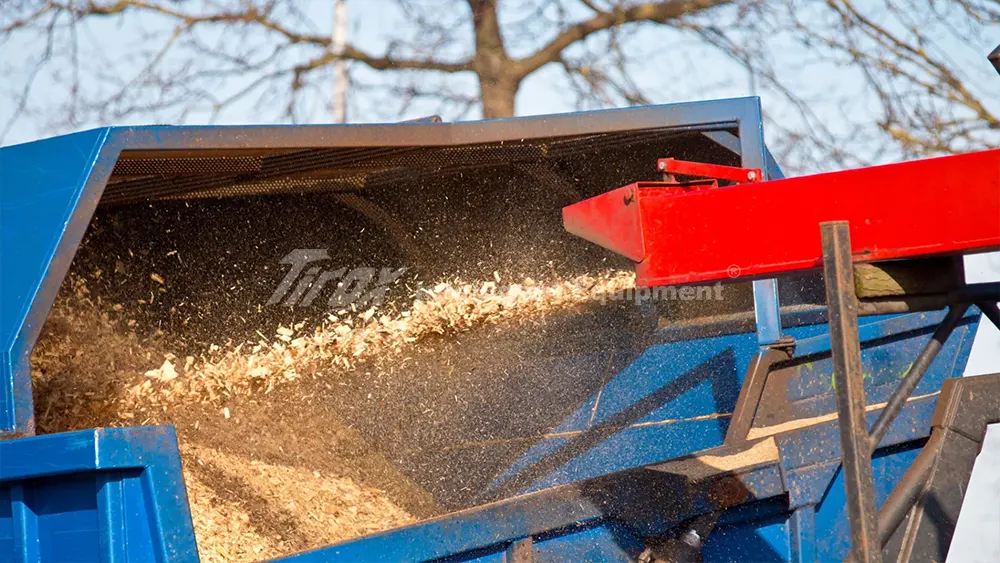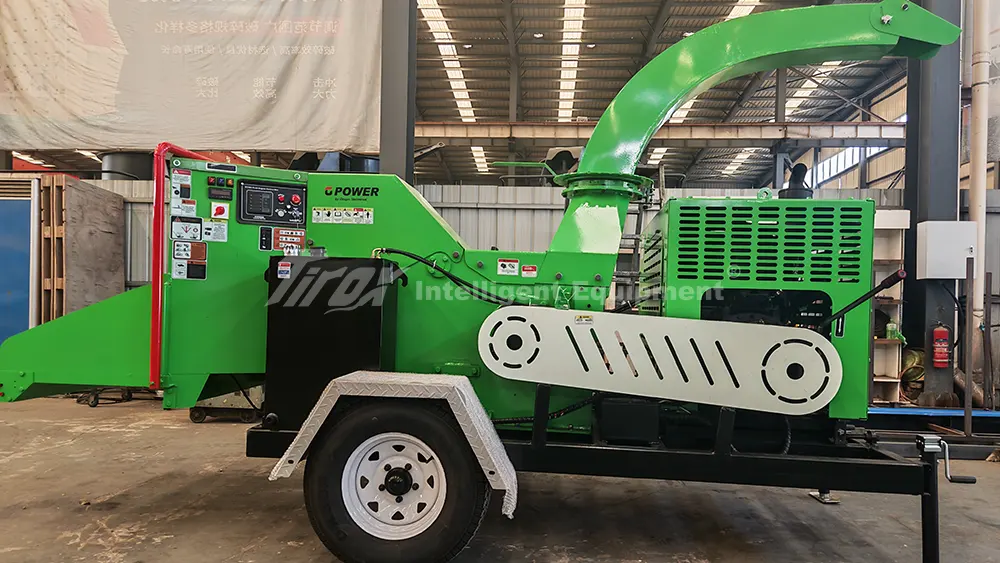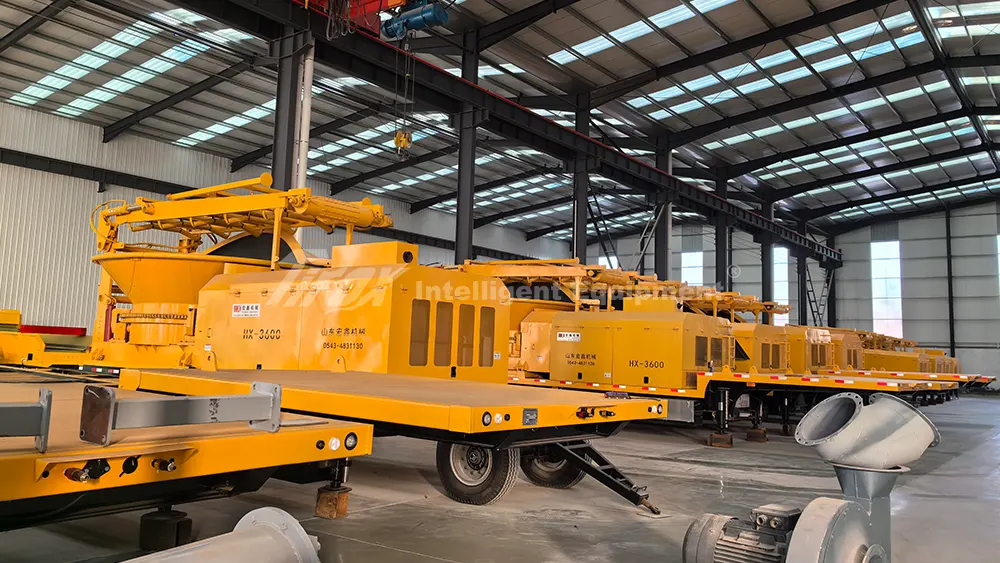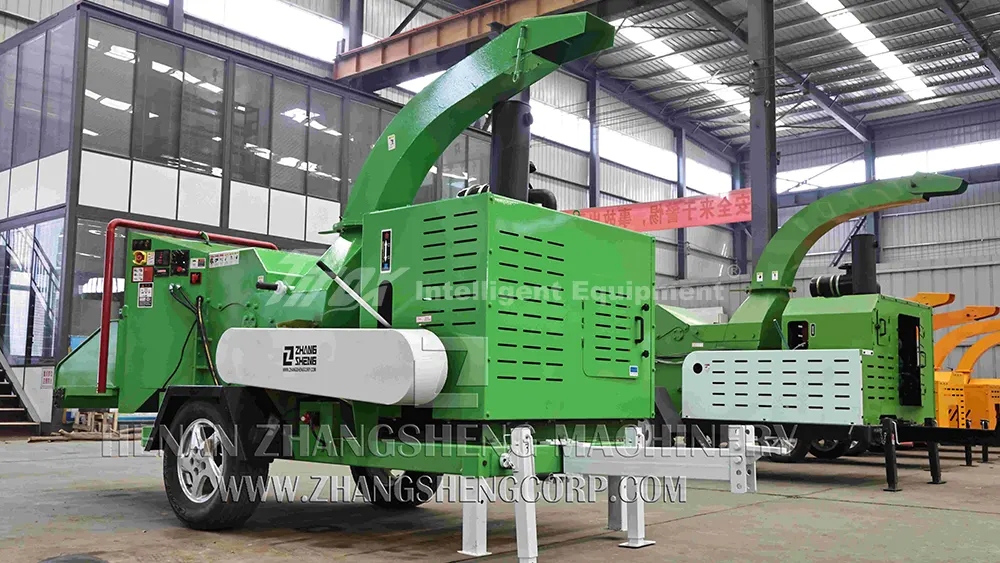You’re looking at your overflowing yard waste pile, a mix of freshly cut grass, leafy weeds, and trimmed branches. It’s tempting to think of your powerful wood chipper as an all-in-one solution. But will it handle everything, or will you end up with a messy, clogged machine?
While wood chippers are excellent for processing woody materials, putting large amounts of grass in them is generally not recommended because their design is optimized for chipping solid wood, and soft, wet materials like grass tend to clog the mechanism.
In my 22 years in the wood equipment manufacturing business at TIROX, I’ve seen many people try to put all sorts of yard waste into a chipper. It’s a common misconception that because it’s “organic,” it will automatically chip. However, understanding the specific design of a wood chipper, especially the cutting mechanisms, is crucial to knowing what it can and cannot handle efficiently.
Can you put weeds in a wood chipper?
You’ve got a bumper crop of weeds from your garden, perhaps some stringy vines or leafy green plants. You’re wondering if your wood chipper, designed to handle tough branches, can also make quick work of these softer, often wet, materials.
It is generally not recommended to put large quantities of weeds into a wood chipper, especially those primarily designed for solid wood, as their stringy and wet nature can easily cause clogs and reduce the machine’s efficiency.

My customers often ask about processing soft, green materials. It is a common question. My observation has been that leaves and very green, wet material behave differently than dry, woody branches or logs. Wood chippers that use a drum or disc with knives are best at cutting solid wood. When you feed a lot of leaves or wet green waste, it tends to compact or wrap around the cutting drum or blades instead of being cleanly cut and discharged. This leads to clogs very quickly. A clogged chipper is not just frustrating; it also stops your work. You have to turn off the machine, wait for everything to stop, and then manually clear the jam. This is when accidents can happen if you are not careful or if the machine starts unexpectedly.
Why Weeds Cause Problems
Weeds, along with grass and other soft, leafy green waste, have high moisture content and a fibrous, stringy texture. This combination is challenging for a wood chipper’s primary cutting mechanism. Unlike solid wood, which breaks cleanly under the impact of sharp blades, soft materials tend to “shred” or “gum up” rather than chip. They can wrap around the rotor or blades, getting stuck in the mechanism and preventing proper discharge. This often leads to blockages in the feed chute or discharge chute, requiring manual clearing, which can be time-consuming and inconvenient. For example, our chippers are designed with a drum or disc that has sharp knives. These knives slice through solid wood. Weeds, however, do not offer the same resistance, making them difficult to process cleanly.
Chipper vs. Shredder
It is important to know the difference between a chipper and a shredder. While some machines are combo “shredder-chippers,” a standard wood chipper is made for woody material. A wood chipper’s main job is to cut branches and limbs into chips using sharp knives [18]. A shredder, on the other hand, uses flails or hammers to break down soft, leafy waste into finer material. If your machine is only a “chipper,” it is primarily for wood branches and logs within its size limit. Putting large amounts of leaves or weeds in it will likely cause problems. For processing large volumes of leaves or green garden waste, a machine designed as a dedicated shredder or a combination shredder-chipper is a better and safer choice. Understanding this difference helps you choose the right machine for the type of yard waste you deal with most.
When a Little is Okay
A small number of leaves or weeds attached to branches is usually fine, as the wood helps pull the leafy material through. However, feeding just large piles of loose weeds, grass, or leaves is generally not recommended for a standard wood chipper. If you need to process large amounts of green waste, consider alternative methods like composting, or look for equipment specifically designed for such materials. For more details on machine types, this article from Popular Mechanics explains the differences between chippers and shredders in depth.
Can you put green branches in a wood chipper?
You’ve finished pruning your trees and shrubs, leaving you with a pile of freshly cut, still green branches. You know your chipper handles wood, but does the “green” and possibly flexible nature of these branches make a difference?
Yes, wood chippers are specifically designed to effectively process green branches and limbs, turning them into chips; in fact, the moisture content in green wood often makes it easier to chip compared to extremely dry wood.

My team at TIROX spends a lot of time engineering machines that can handle the raw materials our customers encounter every day. Green branches are a primary material they are built for. Our chippers are ideal for processing branches up to specified diameters, trees, shrubs, and other woody vegetation. For example, our hydraulic forced feeding system can handle challenging wood materials. This system is designed to adjust its speed based on the material’s diameter, ensuring optimal performance and higher output. This ensures that even fresh, flexible branches are efficiently fed into the cutting mechanism.
Designed for Green Woody Material
The most common materials suitable for wood chippers include freshly cut branches and limbs. These branches typically measure between 1 inch and 6 inches in diameter to ensure optimal performance and prevent potential clogging. While wood chippers can process wood up to 50 cm (almost 20 inches) in diameter, the 1-6 inch range is often ideal for smooth, continuous operation. It is beneficial to work with softwood species, such as pine, spruce, or fir, as they tend to chip more easily compared to hardwoods. However, hardwood branches, like those from oak or maple, can also be processed if they are not excessively large.
Efficiency and Preventing Clogs
Even with green material, proper technique helps prevent issues. For instance, when chipping branches with leaves attached, it’s often best to feed the branch butt-first, allowing the chipper to pull the leafy material through with the wood. Our machines are equipped with intelligent feed systems that monitor the processing load. This system can automatically adjust the feed speed or stop feeding to prevent blockages, ensuring smoother operation [1]. This technology makes processing green branches much more efficient and safer for the operator, as the machine intelligently responds to the material it’s being fed. You can see our wood chipper models like the ZSYL-1263 and ZSYL-1063 on our Tirox wood chippers product page.
The Benefit of Green Chips
Chipping green branches yields chips that are often ideal for various applications. For example, fresh wood chips are excellent for mulching gardens, as they retain moisture, suppress weeds, and enrich the soil as they decompose. They can also be used as compost material or for biomass fuel production. The moisture in green wood means less dust during chipping and often provides a cleaner cut on the chips themselves, making them more uniform and suitable for specific uses.
What can go into a wood chipper?
You’re ready to tackle your woody debris pile, but you want to confirm exactly what your machine is built to handle. You need a clear understanding of the safe and effective materials to ensure efficient operation and machine longevity.
Wood chippers are primarily designed to process woody organic plant matter, including branches of various sizes, limbs, tree trunks within the machine’s specified diameter capacity, and other woody vegetation, transforming them into useful wood chips.
Based on my extensive experience at TIROX, knowing the right materials to feed your chipper is key to its performance and lifespan. Our machines are built to handle tough jobs, but they are specialized tools. We design our equipment, whether it’s a mobile wood chipper or a larger horizontal grinder, with specific raw materials in mind. Wood chippers excel at cutting and processing wood. The blades are sharp and strong, made to cut organic fibers.
Suitable Raw Materials
Here’s a breakdown of what typically goes into a wood chipper:
- Tree Branches and Limbs: This is the primary function. Wood chippers efficiently process branches of various diameters, typically from 1 inch up to the machine’s maximum capacity (e.g., 6 inches for smaller units, or up to 50 cm for industrial models).
- Small Tree Trunks and Stumps: Depending on the model, wood chippers can handle small tree trunks and parts of stumps, provided their diameter fits within the machine’s feed opening and power specifications.
- Shrubbery and Woody Brush: Any plant material that has developed a woody stem, like mature bushes or woody vines (provided they are not excessively long and stringy).
- Forestry and Land Clearing Waste: This includes logging residues such as tree tops and non-commercial wood from thinning operations, as well as general woody debris from land clearing.
- Clean Wood Waste: Untreated and unpainted wood scraps, such as those from construction or manufacturing (e.g., wood boards, strips, pallets, and wooden boxes), can be processed, assuming they fit the feed opening. Raw wood pieces for pallet production can also be chipped.
Our machines, like TIROX wood chippers and horizontal grinders, are designed to create wood chips in various sizes, usually from 5mm to 50mm, suitable for different applications. These chips can be used for biomass fuel, compost, construction boards, or landscaping mulch.
Materials to Avoid
It’s just as important to know what should never go into a wood chipper. Feeding the wrong items can cause serious damage to the machine, create dangerous projectiles, and endanger the operator.
- Metal: Nails, screws, wire, tools, or any metal object will severely damage blades and can break them, turning them into dangerous projectiles. Even a small nail can cause significant issues [16].
- Stones and Rocks: These will dull blades rapidly and can also break blades or other internal components.
- Plastic: Plastic does not chip cleanly; it can melt due to friction, gumming up the machine, or shatter into sharp pieces.
- Glass and Rubber: These materials are not processed effectively by choppers, can cause damage, and pose safety risks.
- Treated or Painted Wood: These can release toxic chemicals into the air and into the resulting chips, making the chips unusable and potentially harmful.
- High Humidity Sludge or Wet Trash: These materials can easily clog the feed system.
By sticking to wood and woody biomass, you ensure safe and efficient operation of your wood chipper [16]. Always verify what your specific model can handle by checking its manual or contacting our professional team for consultation. The University of California’s Master Gardeners program offers good advice on safe chipping practices for various materials.
Conclusion
Wood chippers are valuable tools primarily designed for processing woody materials like branches and trunks into useful chips. While they effectively handle green wood, soft materials like grass and weeds are generally unsuitable due to clogging risks. Always ensure you feed only appropriate materials to maintain safety and machine longevity.






